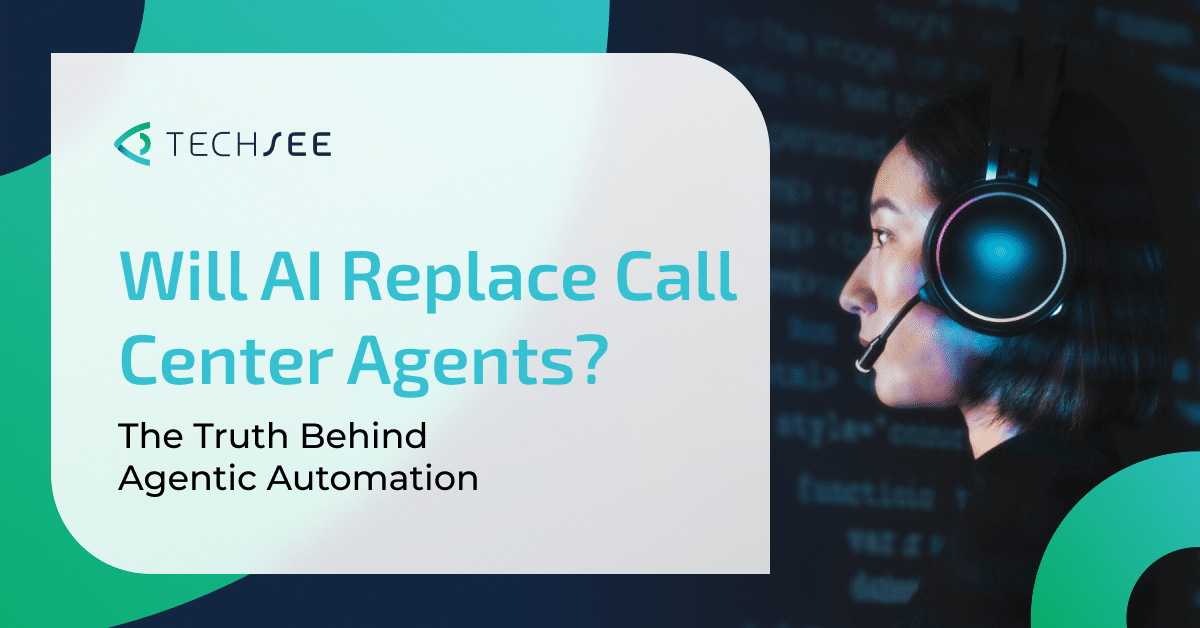Contents
- What the Data Really Shows
- Why Agentless Service Doesn’t Work
- From Chatbots to Agentic AI Call Centers
- The Shift Toward Multimodal AI Assist
- Redefining the Role of the Agent
- The Future of Human-AI Collaboration
- Frequently Asked Questions: AI in Call Center Operations
- Will AI replace call center agents?
- What is Agentic AI in customer service?
- Can AI make a call center fully agentless?
- How is AI improving call center operations today?
- What will the call center of the future look like?
- How does artificial intelligence (AI) help reduce waiting times?
- How can AI enhance the customer journey?
- Does AI impact agents’ productivity and morale?
The question of whether AI will replace call center agents has become one of the biggest debates in customer service. Predictions of agentless call centers often resurface each time a new AI capability appears. Yet the evidence tells a different story.
According to Gartner, by 2028, none of the Fortune 500 companies will have fully eliminated human service agents. The same research indicates that half of the organizations planning to significantly reduce their workforce through AI will abandon those plans by 2027. The reality is that AI is changing what agents do, not eliminating their role.
What the Data Really Shows
AI has already enhanced contact center efficiency, but humans remain essential. In a recent Gartner survey, 54% of service leaders said that generative AI call center tools helped them scale their operations without reducing headcount. Only 11% reported any reduction in frontline roles.
Most of the gains so far have come from automation of repetitive and low-value tasks. This allows organizations to serve more customers with the same number of employees. Rather than shrinking their workforce, leaders are using AI to extend it. In fact, they are focusing human attention on complex and high-impact interactions.
Why Agentless Service Doesn’t Work
Some companies that moved aggressively toward full automation have had to reverse course and rehire agents. The reason is simple. AI systems still struggle with ambiguity, exceptions, and emotionally charged cases. When a situation has no clear answer, AI can deliver incomplete or incorrect information.
Human agents remain essential in high-risk scenarios where the cost of a mistake can be serious for both the customer and the business. They can identify when information is missing, interpret tone, and adapt their approach in real time. Removing them entirely exposes organizations to reputational and operational risks that outweigh the savings. The long-term value lies not in removing agents but in redefining their contribution.
From Chatbots to Agentic AI Call Centers
Early chatbots were built to handle simple interactions such as account status or delivery updates. They helped deflect volume but often left customers frustrated when issues fell outside their scripts. Modern systems powered by Agentic AI are taking a different path.
Agentic AI can plan, execute, and adjust its actions independently. This enables it to complete tasks that extend beyond a single response. It can access multiple systems, track progress, and decide when human support is required.
This makes it more effective than static chatbots, allowing agents to focus on cases that require reasoning or empathy. Generative and Agentic AI now work together to create dynamic workflows, blending autonomous actions with human oversight. The outcome is not fewer agents, but more capable ones.
The Shift Toward Multimodal AI Assist
AI tools are evolving from simple self-service to AI agent assist platforms. Early AI programs focused on automating simple, repetitive issues through self-service, such as password resets or account activations. The next phase is about enhancing how agents handle those problems through AI-assist tools.
Modern AI-powered customer service systems, including Agentic AI, take a more sophisticated language model approach. They use natural language processing (NLP) to understand customer intent, tone, and context. In fact, current AI-powered assist tools can retrieve information, summarize past interactions, and recommend next steps during live sessions.
However, they are still limited in understanding complex or technical issues. The next generation of assist tools is becoming multimodal, meaning they can process text, speech, and visual data together. A multimodal AI system can see the customer’s issue and recognize technical details.
Plus, it can suggest a solution that the agent can confirm or adjust. It can drive real customer service automation. This shift enables AI to become a true collaborator, rather than just a background tool. The agent gains insight and speed, while the customer gains clarity and trust.
Redefining the Role of the Agent
As AI systems mature, the role of the agent is becoming more specialized. Agents are moving from transactional work to roles that involve analysis, judgment, and personalized support. Their skill set now includes understanding how to interpret AI recommendations, verify information, and decide when to escalate.
This evolution mirrors other industries adopting AI. Technology takes over the routine, while people manage complexity. The best-performing service organizations invest in training that blends technical fluency with emotional intelligence. The result is a workforce that works with AI, not against it.
As agents gain access to advanced assist tools, they become more empowered in their roles. The shift toward higher-value problem-solving and decision-making increases their confidence, skill, and sense of contribution. At the age of AI, this upskilling can reduce attrition and improve job satisfaction.
There is also a well-documented link between agent happiness and improved customer satisfaction. When service representatives feel equipped and valued, they deliver more authentic, empathetic experiences. We believe the future holds a more motivated workforce and stronger, more consistent customer relationships.
The Future of Human-AI Collaboration
AI-driven assist tools are boosting agents’ productivity by providing real-time insights, summarizing interactions, and automating post-call documentation. However, the contact center of the future will not be agentless. It will be hybrid. AI will handle predictable and repeatable tasks, while humans manage the exceptions and the emotions.
AI call center automation will enable seamless real-time collaboration, improving contact center efficiency without removing the human touch. Multimodal and Agentic AI will help bridge the gap between these two layers. It will enable people and machines to share context in real-time.
Companies that treat AI as a capacity multiplier rather than a headcount reducer will lead this transformation. They will build service operations that are faster, smarter, and more resilient without losing the human connection that defines great customer experiences.
Frequently Asked Questions: AI in Call Center Operations
Will AI replace call center agents?
AI will not replace call center agents, but it will change how they work. It will automate repetitive interactions and support agents during complex issues. This will allow them to focus on empathy and problem-solving that technology cannot replicate.
What is Agentic AI in customer service?
Agentic AI refers to systems that can plan and perform actions independently across multiple systems. In customer service, it enables automation that adapts to each case and works in tandem with agents, rather than operating in isolation.
Can AI make a call center fully agentless?
No. Gartner projects that 0% of Fortune 500 companies will achieve fully agentless service by 2028. The best results come from a hybrid approach that combines automation efficiency with human oversight and trust.
How is AI improving call center operations today?
AI is improving contact centers by automating routine inquiries, reducing handling time, and surfacing relevant insights for live agents. These efficiencies help organizations support more customers without lowering service quality.
What will the call center of the future look like?
The future call center will use multimodal AI systems capable of interpreting text, voice, and visuals. Human agents will manage strategy, escalation, and customer relationships while AI agents handle routine and data-driven work in the background.
How does artificial intelligence (AI) help reduce waiting times?
AI-powered routing systems analyze customer intent in real time and connect them with the best automated workflow. By predicting issue types and prioritizing based on urgency, artificial intelligence (AI) helps reduce waiting times. It ensures faster resolution across all channels.
How can AI enhance the customer journey?
AI tracks interactions across multiple touchpoints. From chat to email to voice, it builds a unified view of each customer’s journey. This context allows agents to deliver more personalized responses and helps businesses identify friction points before they impact satisfaction.
Does AI impact agents’ productivity and morale?
Absolutely. Intelligent AI agent-assist tools automate repetitive tasks and summarize calls. It can also suggest next actions in real-time, significantly improving agents’ productivity.






